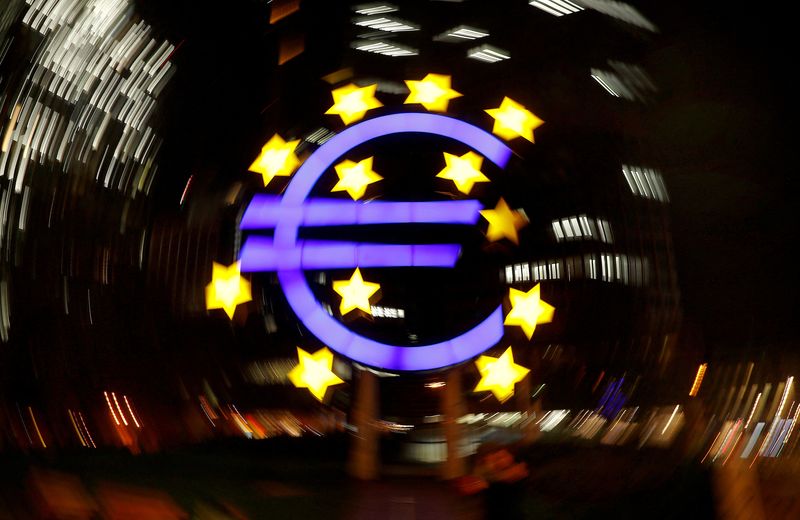By Yoruk Bahceli and Harry Robertson
(Reuters) – Euro zone governments will have to charm private buyers to step in and buy 400 billion euros of additional debt next year, which will keep the bloc’s battered bond markets under pressure as the European Central Bank further unwinds its support.
The ECB, effectively a guaranteed debt buyer since it launched quantitative easing (QE) in 2015, even hoovering up all the new bonds governments sold from at least 2019 to 2021, will start offloading its holdings.
As governments scramble to soften the blows from soaring energy prices, they require extra funds. Germany is set to issue a record amount of debt next year. The amount of new public-sector debt investors will have to absorb in 2023 will be twice as much as the previous record a decade ago, BofA notes.
That means issuers are going to have to work harder to find takers, and risk paying up further after an unexpectedly hawkish ECB last week prompted investors to price in half a percentage point of additional rate hikes next year.
Though it will still reinvest maturing debt bought during the pandemic, the central bank will offload bonds from its 5 trillion euro portfolio at a rate of 15 billion euros a month between March and June. What happens afterwards is not clear, which adds to uncertainty.
As early as November, the ECB’s bond market contact group cited the high amount of debt private investors would have to buy as the most frequently mentioned concern.
“We do see little appetite among investors to be buyers of European bonds next year,” said Julian Le Beron, chief investment officer for core fixed income at Allianz Global Investors.
He is selling German bonds to buy U.S. Treasuries, which many investors favour, saying there is less uncertainty around growth and inflation.
“You’ve got this triple-whammy, you’ve got a hawkish ECB, you’ve got the pace of quantitative tightening and then you’ve also got this quite large government bond issuance in the first quarter,” Le Beron said.
German yields have already shot up 250 basis points (bps) this year and Italian yields are up more than 300 bps, including 50 bps in the last week alone.
Analysts at BNP Paribas, Deutsche Bank and Citigroup, three of the four leading banks running euro government debt sales according to Refinitiv, expect yields to continue rising into next year.
BNP cites debt sales as one factor that it expects to push up Germany’s 10-year yield another 45 bps to 2.75% in the first quarter.
(Graphic: Many investment banks expect Bund yields to rise in Q1: https://www.reuters.com/graphics/EUROZONE-BONDS/myvmooqklvr/chart.png)
BofA says quantitative tightening is starting earlier than investors it surveyed had expected, increasing the likelihood of a “breakdown”, where markets cannot digest more issuance without investors demanding higher yields.
Investors will also have to grapple with Italy’s debt sustainability. Yields are now above the 4% level that begins to worry investors. A “higher for longer” ECB adds to those concerns, BofA said.
However, not all banks believe yields will rise next year. JPMorgan, the leader for euro government debt sales, expects a fall. Others, including BNP, also see yields falling after an initial rise.
The hope is that higher yields will lure buyers and a likely recession will eventually make lower-risk assets like bonds more attractive – a wider theme across global bond markets.
“If we see, as we expect, some sort of a slowdown but not a heavy, deep recession then there is scope… to look at the euro zone as a market in which it could be interesting to increase duration,” said Cosimo Marasciulo, a fund manager at Europe’s largest asset manager Amundi, referring to interest rate risk.
WHO BUYS?
Chris Jeffery, head of rates and inflation strategy at Legal and General Investment Management, said without the ECB, the region’s banks would have to buy the debt.
“The banks are the only kind of sector which can create their own liabilities when buying assets,” Jeffery said.
That they have, as JPMorgan noted last month, already stepped in since the summer in some countries, may be a positive sign.
To make the debt more attractive, Jeffery said there also needed to be a further drop in swap spreads – which measure the premium on the fixed-leg of an interest rate swap, used by investors like banks to hedge against rates risk, relative to bond yields.
Pension funds and insurer clients are also interested, said Gerard Fitzpatrick, head of fixed income at Russell Investments.
The biggest challenge for governments will be timing, Dutch debt office head Saskia van Dun told Reuters last week.
They will also have to be careful when picking maturities to issue and compensate investors enough to buy the debt, investors said.
“With QE having been in the system for a long time, which was taking out that net supply, now you’re going to see private investors be the marginal price setter,” said Snigdha Singh, co-head of fixed income, currencies and commodities trading for EMEA at BofA.
(Graphic: European issuance to surge: https://fingfx.thomsonreuters.com/gfx/mkt/lgpdkkqjxvo/bofa%20issuance%20chart.png)
(Reporting by Yoruk Bahceli and Harry Robertson; editing by Amanda Cooper, Kirsten Donovan)
